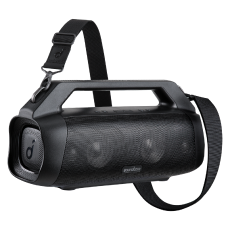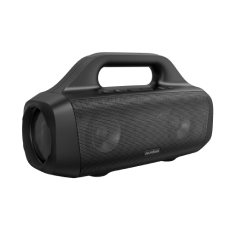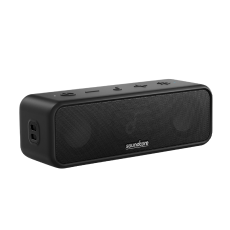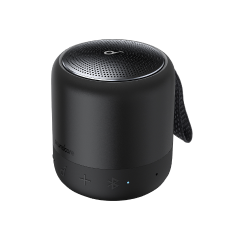What is a Subwoofer? An In-Depth Look
So, you've heard the term "subwoofer" thrown around in conversations about audio systems, home theaters, or maybe even in a car accessories shop. But what is a subwoofer, really? If you're curious to unravel the mystery behind this powerful component and how it can transform your audio experience, you're in the right place.
Now, what exactly is a subwoofer and how does it work? Continue on below to find out.

- Incredible Sound Loved by 20 Million+ People
- Epic Outdoor Sound: 80W booming sound is delivered by two 30W woofers and 10W tweeters, while real-time intensified bass can be heard with Soundcore's proprietary BassUp technology. To improve treble performance of Motion Boom Plus outdoor speaker, titanium drivers ensure an all-around epic sound.
- Lightweight and Ultra-Portable: Take your tunes everywhere you go with Motion Boom Plus Bluetooth speaker's built-in handle and detachable strap.
- 20-Hour Playtime: Motion Boom Plus outdoor speaker is equipped with a 13,400mAh battery capacity with 20 hours of playtime to save you the trouble of frequent charging and make listening more enjoyable.
- Water and Dust Resistant: With an IP67 certification, you'll never have to worry about water splashes, rain, accidental spills, or dust while you're out and about with your Motion Boom Plus outdoor speaker.
- Note : For peak performance, please use the soundcore app and update to the latest firmware.
What Is a Subwoofer?
A subwoofer is a specialized speaker designed to reproduce low sound frequencies, known as bass. These frequencies typically range from 20 to 200 Hz. Unlike standard speakers that cover a broad spectrum of sound, a subwoofer focuses specifically on the low-frequency range, enhancing the depth and impact of the audio experience.
But, what does a subwoofer do? Simply put, it adds depth, dimension, and richness to the audio we hear, bringing a more immersive and realistic experience to music, movies, and games. Then, what is a subwoofer speaker used for? They are commonly used in home theater systems, music setups, and professional audio applications to provide a more immersive and full-bodied sound.
How Does a Subwoofer Work?
Understanding how subwoofer speakers works requires looking at its key components and the process it follows to produce low-frequency sounds. Here's a detailed explanation:
- Sound Signal: The audio system sends a low-frequency sound signal to the subwoofer.
- Amplification: Active subwoofers have a built-in amplifier that boosts the signal. Passive subwoofers use an external amplifier.
- Vibration: The amplified signal reaches the subwoofer's driver, causing it to vibrate.
- Air Movement: The vibration of the driver moves the air, creating sound waves that are perceived as bass. The size of the driver affects the amount of air movement and the depth of the bass.
- Ported or Sealed: Subwoofers may have ports or sealed designs that influence the bass sound. Ported designs allow air to escape, enhancing the bass, while sealed ones provide more control over the sound.
Key Components:
- Driver: The component of the subwoofer responsible for creating vibrations.
- Amplifier: Increases the signal strength, essential for active subwoofers.
- Enclosure: The housing for the driver, is designed to optimize sound production.
- Crossover: A circuit that directs specific frequencies to the subwoofer and other speakers.
The operation of a subwoofer involves converting electrical signals into sound waves, specifically targeting the low-frequency range. This process adds richness and depth to the overall sound quality, allowing listeners to experience the nuances of bass in music, movies, and other audio content.
Main Types of Subwoofers
When you're exploring the world of subwoofers, you'll come across various types, each with its unique characteristics and applications. Let's delve into at least four main types of subwoofers, so you can understand what sets them apart:
1. Active Subwoofers
- Description: An active subwoofer comes with a built-in amplifier. This means it has its own power source and doesn't rely on an external amplifier.
- Usage: Ideal for home theater setups and live sound systems where convenience and ease of installation are key.
- Pros: Simplifies the setup process, and offers more control over sound settings.
- Cons: Requires a separate power outlet, which may be more expensive.
2. Passive Subwoofers
- Description: What is a passive subwoofer? Unlike active subwoofers, passive ones need an external amplifier to power them.
- Usage: Common in custom audio systems where separate components are preferred.
- Pros: Allows for more flexibility in choosing the amplifier, often lighter due to the absence of a built-in amplifier.
- Cons: Requires careful matching with an external amplifier, more complex setup.
3. Ported Subwoofers
- Description: These subwoofers have an extra hole or port that allows air to escape, often through a tube.
- Usage: Suitable for those who prefer a boosted bass level in their sound system.
- Pros: Enhances the bass response, creating a more resonant sound.
- Cons: May lack tight control over sound, larger in size.
4. Sealed Cabinet Subwoofers
- Description: A sealed cabinet subwoofer has no port or passive radiator, meaning the bass only has one route to leave the cabinet.
- Usage: Preferred for a more controlled and well-rounded sound.
- Pros: Offers a tighter and more accurate bass response.
- Cons: May lack the depth and resonance of ported designs.
Choosing the Right Type
Understanding the main types of subwoofers helps you make an informed decision based on your specific needs and preferences. Whether you're looking for a plug-and-play solution like an active subwoofer or a more customized approach with a passive one, knowing the differences guides you in the right direction.
Are you a bass enthusiast craving a resonant sound? A ported subwoofer might be your choice. Or perhaps you value accuracy and control? A sealed cabinet subwoofer could be the way to go.
Take note that the choice of a subwoofer isn't just about the type; it's about how it fits into your overall sound system and enhances your listening experience. Consider factors like size, placement, compatibility with other speakers, and, of course, your budget.

- Incredible Sound Loved by 20 Million+ People
- Epic Outdoor Sound: 80W booming sound is delivered by two 30W woofers and 10W tweeters, while real-time intensified bass can be heard with Soundcore's proprietary BassUp technology. To improve treble performance of Motion Boom Plus outdoor speaker, titanium drivers ensure an all-around epic sound.
- Lightweight and Ultra-Portable: Take your tunes everywhere you go with Motion Boom Plus Bluetooth speaker's built-in handle and detachable strap.
- 20-Hour Playtime: Motion Boom Plus outdoor speaker is equipped with a 13,400mAh battery capacity with 20 hours of playtime to save you the trouble of frequent charging and make listening more enjoyable.
- Water and Dust Resistant: With an IP67 certification, you'll never have to worry about water splashes, rain, accidental spills, or dust while you're out and about with your Motion Boom Plus outdoor speaker.
- Note : For peak performance, please use the soundcore app and update to the latest firmware.
Why Do You Need a Subwoofer?
You've learned about what a subwoofer is and how it functions. But the real question is, why should it find a place in your audio setup? Here are some great reasons why:
Elevate Your Audio Experience
A subwoofer isn't just another speaker; it's a game-changer. It specializes in delivering those low-frequency sounds that other speakers might struggle with. So, when you're watching an action-packed movie or jamming to a song with a deep bass line, a subwoofer ensures you don't just hear the sound, but you feel it. It adds depth, richness, and a touch of drama to your audio. This is especially convenient if you have a Bluetooth speaker with subwoofer.
Relieve Your Main Speakers
Your main speakers are great, but they have a lot on their plate. By introducing a subwoofer into your sound system, you're allowing your main speakers to focus on what they do best: producing mid and high-frequency sounds. The speaker with subwoofer allows for division of labor means less distortion and a clearer, crisper sound overall.
Customize Your Sound
One of the great things about having a subwoofer is the ability to tailor your audio experience. Love a heavy bass? Turn it up. Prefer something a bit more subtle? Dial it down. A subwoofer gives you the flexibility to adjust the bass to your liking.
Enhance Your Home Theater
If you're a movie buff, a subwoofer is a must-have. It takes your home theater experience to the next level. Visualize the suspense of a thriller, the roar of an action scene, or the emotion of a drama—all amplified with the power of a subwoofer. Even better, using a portable Bluetooth speaker with subwoofer allows you to enjoy your entertainment on the go.
Are you in the market for a subwoofer, have you checked out the soundcore Motion Boom Plus speaker?
Boasting a massive 80W output, this speaker combines two 30W woofers and 10W tweeters to deliver crystal-clear sound. Enhanced with soundcore's BassUp technology and titanium drivers, it promises unparalleled audio clarity. Lightweight and designed for portability, it features a handy built-in handle, a detachable strap, and a robust 20-hour playtime from its 13,400mAh battery. Plus, its IP67 rating ensures it's resistant to both water and dust.
FAQ
Does a Subwoofer Make Speakers Sound Better?
Definitely, a subwoofer specializes in producing low-frequency sounds, which many regular speakers might struggle with. By adding a subwoofer to your sound system, you're filling in that bass gap. This means your main speakers can focus on the mid and high frequencies, resulting in a more balanced and full sound spectrum. So, not only does the bass get a boost, but the overall sound quality of your system improves.
Is a Subwoofer Only for Bass?
While a subwoofer's primary role is to produce bass, it's not just about that low rumble. It's about enhancing the overall depth and richness of the audio. Think of it as the foundation of your sound. Without a strong foundation, the rest of the building (or in this case, sound) might not be as stable or impactful. So, while bass is its main gig, a subwoofer's influence extends to the overall sound experience.
Where Should a Subwoofer Be Placed?
Placement can make a significant difference in how your subwoofer performs. While there's no one-size-fits-all answer, here are some general guidelines:
- Corner Placement: Placing your subwoofer in a corner can amplify the bass, making it sound louder.
- Along the Front Wall: This can offer a more accurate bass response, especially if placed between the front speakers.
- Avoid Enclosed Spaces: Placing a subwoofer inside a cabinet or shelf can muffle the sound.
- Experiment: Every room is unique. It's a good idea to try different spots and see where the bass sounds best to you.
Conclusion
Getting into subwoofers can be both fun and a little bit stressful. But now that you know more, you can make choices that are good for you. It's key to note that a subwoofer isn't just about adding volume; it's about enhancing the quality, depth, and richness of your audio experience.
Regardless if you're setting up a home theater, upgrading your music system, or just looking to feel that movie explosion in your bones, a subwoofer is your ticket to a sound that resonates.

















































